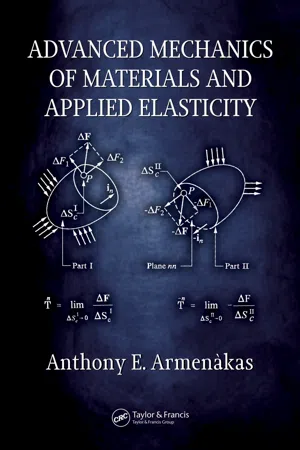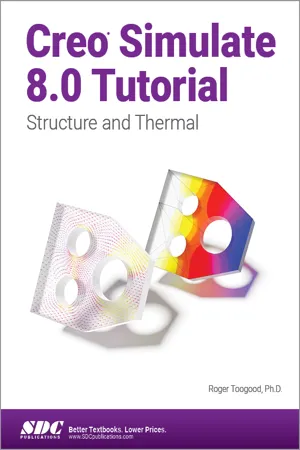Technology & Engineering
Plane Stress
Plane stress refers to a condition in which a material is subjected to stress in only two dimensions, typically in the x-y plane. This means that the stress in the third dimension (z-direction) is negligible. It is a common assumption in engineering analysis for thin structures, such as plates and shells, where the effects of stress in the thickness direction can be ignored.
Written by Perlego with AI-assistance
Related key terms
1 of 5
4 Key excerpts on "Plane Stress"
- Anthony E. Armenakas(Author)
- 2016(Publication Date)
- CRC Press(Publisher)
The components of stress of thin plates obtained on the basis of the two-dimensional or generalized Plane Stress approximation represent a good approximation of the actual components of stress acting on particles sufficiently removed from their lateral surfaces. Moreover, their accuracy increases as the thickness of the plate decreases. In what follows we present two examples. Plane Strain and Plane Stress Problems in Elasticity 296 (a) Example 2 Establish an approximation to the stress distribution in a cantilever prismatic beam of a very narrow rectangular cross section (small thickness to depth ratio) subjected 1 at its free end ( x = L ) to a distribution of traction which is statically equivalent to a force 1 3 3 3 whose line of action lies in the x x plane and it is equal to P i [see Fig (a)]. The dimensions of the cross section of the beam are small compared to its length. The free-body diagram of the beam is shown in Fig. a. The boundary conditions of the beam under consideration do not correspond to those 21 required to maintain a state of plane strain in it. In order that a state of plane strain ( e = 23 22 e = e = 0) exists in the beam it must be subjected to a distribution of normal component 2 of traction on its sides x = ± b of the magnitude required to render the component of 2 1 2 3 displacement û ( x , x , x ) equal to zero. However, since the cross sectional dimensions of the beam are small compared to its length and its cross section is narrow b << h , we can obtain an approximate solution by considering the beam as being in a state of Plane Stress. Figure a Cantilever beam of rectangular cross section. Solution Part a State of plane strain In this part we assume that the beam is in a state of plane strain.- eBook - PDF
Creo Simulate 8.0 Tutorial
Structure and Thermal
- Roger Toogood Ph.D.(Author)
- 2021(Publication Date)
- SDC Publications(Publisher)
3. All entities for the model must be in the XY plane of the coordinate system. This includes all model geometry, constraints, and loads. 4. For axisymmetric models (these are also 2D models), the model must all be on the positive X side of the coordinate system, X > 0. In this lesson, we will examine Plane Stress and plane strain models. Axisymmetric problems are also based on planar models, but we will defer these to the next lesson. 5 - 2 Plane Stress / Plane Strain 1 If there are out-of-plane loads, the model must be treated using shells, which are discussed in Lesson #7. 2 In fact, all stress components in the Z direction are zero. Figure 1 Flat plate solid model Figure 2 Flat plate dimensions in mm (20 thick) We’ll also explore the use of symmetry to further reduce the size of the model (and hence its computational cost). The use of simulation features (coordinate systems, datum curves, regions) is also introduced as well as pressure and temperature loads. These features are also useful for 3D models. And as usual, there are Questions for Review and some suggested Exercises at the end. Plane Stress Models A Plane Stress problem arises when a model is very thin in one dimension compared to the other two. A typical example is a thin flat plate. Because the part/model must stay in the same (XY) plane, loads must also be applied only in the plane of the plate 1 . In this case, the normal stress σ ZZ (perpendicular to the plate) is assumed to be zero throughout its thickness 2 . Normal stresses σ XX and σ YY are in the plane of the model and are constant through the model thickness. The equations that govern Plane Stress problems are considerably simplified, and Plane Stress models are among the fastest to compute. The example problem we will study concerns the stress analysis for the thin flat plate shown in Figure 1. Create this model (call it psplate) in Creo as follows and according to the dimensions in Figure 2. - eBook - PDF
Strength of Materials
A New Unified Theory for the 21st Century
- Surya Patnaik, Dale Hopkins(Authors)
- 2003(Publication Date)
- Butterworth-Heinemann(Publisher)
Two-Dimensional Structures 10 The truss, beam, shaft, and frame structures analyzed thus far are made of slender members with lengths much greater than their depths or thicknesses. Because the mass distribution dominates along the single length dimension, these are also referred to as one-dimensional structures or frameworks. Plates and shells are examples of two-dimensional structures. Two dimensions (or spans) of such structure are comparable and large. The third dimension or the thickness (or depth) is small compared to the other two dimensions. The analysis of a two-dimensional structure is difficult and beyond the scope of this textbook. However, strength of materials addresses two topics of the two-dimensional structures: 1. Analysis of stress state is a two-dimensional structure, or two-dimensional stress state. 2. Analysis of simple shells. Both topics are introduced in this chapter. 10.1 Stress State in a Plate A plate is shown in Fig. 10-1. Its dimensions along the x -and y -coordinate directions are a 12 in : and b 6 : 0 in : , respectively. It has a small uniform thickness ( t 0 : 25 in : ) as shown in Fig. 10-1 b . It is a two-dimensional structure because a / t 48 1 and b / t 24 1. The plate is made of steel with a Young's modulus E of 30,000 ksi and a Poisson's ratio v of 0.30. It is restrained along the boundary nodes (1 and 4). It is subjected to a 1.5-kip load at node 2 along the y -coordinate direction and a 1.0±kip load at node 3 along the x -coordinate direction. The analysis of the plate requires advanced solid mechanics formulation, and it is not covered in strength of materials. We will assume that it has been analyzed as a membrane 441 structure. In such an analysis, the stress state is considered to be uniform across the thickness and only three stress components are induced. These are the two normal stresses ( s x , s y ) and a shear stress, which is symmetrical ( t xy t yx t ). - eBook - PDF
- William F. Riley, Leroy D. Sturges, Don H. Morris(Authors)
- 2018(Publication Date)
- Wiley(Publisher)
86 CHAPTER 2 ANALYSIS OF STRESS: CONCEPTS AND DEFINITIONS 30° 60° 90° 120° 150° Angle θ σ n τ nt 180° 40 30 20 10 0 –10 –20 12 ksi x θ y n t 25 ksi 7 ksi Stress σ n or τ nt , ksi (a) (b) Figure 2-31 shearing stress τ nt on the different planes vary as shown in Fig. 2-31b. Note that, for θ = 0 ◦ , σ n = σ x and τ nt = τ xy ; and for θ = 90 ◦ , σ n = σ y and τ nt = −τ yx = −τ xy . For design purposes, critical stresses at the point are usually the maximum tensile stress and the maximum shearing stress. For a bar under axial load, the planes on which maximum normal stresses and maximum shearing stresses act are known from the results of Section 2-6. For more complicated forms of loading, these stresses can be determined by plot- ting curves similar to those shown in Fig. 2-31b for each different state of stress encountered, but this process is time-consuming and inefficient. Therefore, more general methods for finding the critical stresses have been developed. The transformation equations for Plane Stress developed previously are as follows: For normal stress σ n , σ n = σ x + σ y 2 + σ x − σ y 2 cos 2θ + τ xy sin 2θ (2-12b) For shear stress τ nt , τ nt = − σ x − σ y 2 sin 2θ + τ xy cos 2θ (2-13b) Maximum and minimum values of σ n occur at values of θ for which dσ n /dθ is equal to zero. Differentiation of σ n with respect to θ yields d σ n d θ = −(σ x − σ y ) sin 2θ + 2τ xy cos 2θ (a) 2-10 PRINCIPAL STRESSES AND MAXIMUM SHEARING STRESS—Plane Stress 87 Setting Eq. (a) equal to zero and solving gives tan 2θ p = 2τ xy σ x − σ y (2-14) Note that the expression for dσ n /dθ from Eq. (a) is numerically twice the value of the expression for τ nt from Eq. 2-13b. Consequently, the shearing stress is zero on planes experiencing maximum and minimum values of normal stress. Planes free of shear stress are known as principal planes. Normal stresses occurring on principal planes are known as principal stresses.
Index pages curate the most relevant extracts from our library of academic textbooks. They’ve been created using an in-house natural language model (NLM), each adding context and meaning to key research topics.



